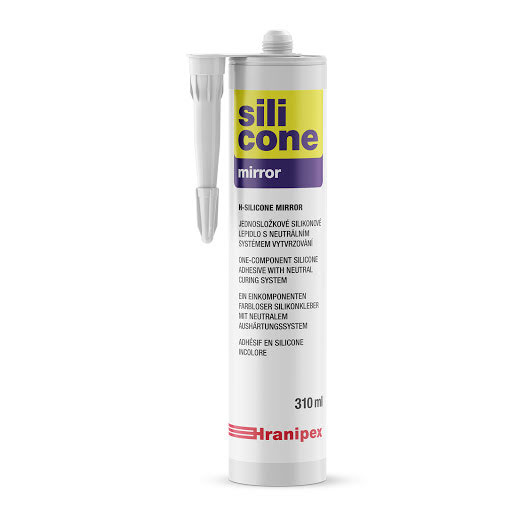H-SILICONE Mirror - Transparent Neutral Silicone

Product description
H-SILICONE mirror is an one-component colourless adhesive without solvents. It has excellent adhesion to most materials and surfaces common in the construction industry: glass, raw and painted wood, tile, brick, concrete, aerated concrete, cement, mortar, laminated glass, metal and most non-malleable plastics. Due to its excellent consistency and colour, it allows the edges of mirrors to be sealed. The consistency and colour also allow to seal the edges of mirrors.
USAGE / EXAMPLE OF USE
- mounting of decorative mirrors on different surfaces, e.g. glaze, glass, plaster, concrete, OSB, wood, plywood
- bonding mosaic mirrors (mirror-mirror bonding) in shower cabins
- mounting mirrors on surfaces exposed to vibration and stress (new construction)
- mounting mirrors and bulky lacobel tiles (e.g. in building systems with sliding doors)
- grouting edges of mirrors (after fully cured elements that were glued)
- bonding mirrors in the metal, wood or plastic frames
- mounting glass elements outdoors
TECHNICAL DATA & SUITABLE WORKING CONDITIONS
Parameter | Value |
Appearance | Pasty |
Colour | Colourless |
Processing time | approx. 10 min |
Time of the full hardering by relative 55% humidity | 2mm/24 hrs |
Application´s time (use) | from +5 to +40°C |
Thermal resistance (cured product) | from -40 to +180°C |
The transverse elastic modulus 23°C according to ISO 8339 | 0,29 – 0,30 N/mm2 |
Shore A Hardness | 19 Sh A |
Density | 1,00 – 1,05 g/cm3 |
Elongation at break according to ISO 8339 | 200 % |
Efficiency | Approx. 18lm of weld size 4x4mm is obtained from the cartridge 310 ml |
APPLICATION / HANDLING
The surface, which is to be applied H-SILICONE Mirror, should be clean and free of dust, dirt, oil, grease, rust and other substances that impair adhesion. Glass, glazed surfaces, wood must be degreased with alcohol, white spirit or other solvent. Rusty steel surfaces should be cleaned with a wire brush, oxidized metals (e.g. copper, lead) - sanded, and then secured against corrosion. Remove remnants of the old sealant before carrying out maintenance work.
It is recommended to perform an adhesion test on the surface before using the product. In case of mirrors from unknown manufacturer, an adhesive test should be carried out before gluing. The mirror should be secured in accordance with DIN EN 1036:2001 'Glass in building'. In case of lacobel tiles from an unknown manufacturer, an application test should be done before gluing to verify whether there is any change in colour of the working surface of lacobel tiles.
Silicone does not require a primer, but on the specific surfaces there may be a need to use a primer. Prior to silicone application the rim should be secured with masking tape. Cut the tip of the cartridge, leaving part of the thread. Screw the applicator at the thread, cut at an angle adjusted to the width of the joint. Apply with a manual or pneumatic gun. The product should be applied in parallel, vertical strand or by point application to allow evaporation of curing silicone by-products. Do not seal the edges of mirror until the silicone is cured. Depending on the size and weight of the mirror, after gluing, it should remain supported by several hours.
Silicone can be smoothed with a spatula for silicone spreading that is dampened in a solution of soap. Use tools from plastic or stainless steel. Silicone is cured by reaction with moisture from the air, therefore, the seal should be performed under conditions that allow access of air. Washing of cured sealant with commercially available cleaning agents prolongs the lifespan.
CLEANING
After use, wipe the tools with a paper towel and clean with solvent.
PRECAUTIONS FOR SAFE USING
Please consider the material safety data sheet of the product prior to handling.
STORAGE
Store in original packaging in a dry and cool place for a period of 18 months from the production date at temperatures from 5 up to 35°C. Protect from freezing temperatures! Keep out of the reach of children!
TRANSPORT
Information concerning safety and handling through the transport please refer to the Safety Data Sheet.
